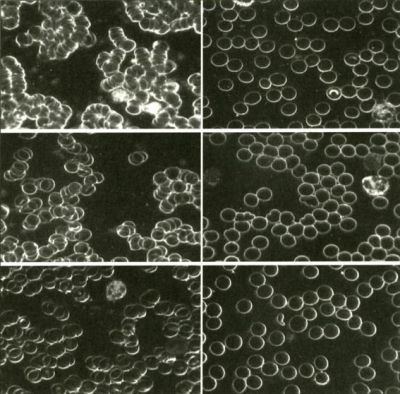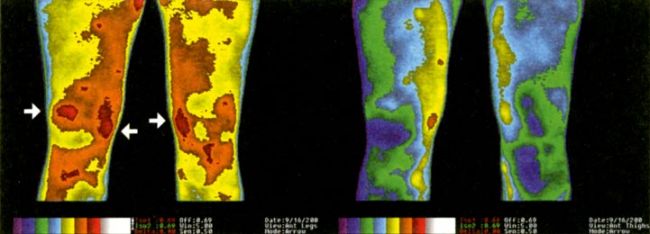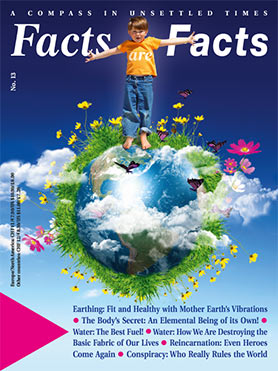Earthing—Get Healthy and Vital by Going Barefoot!
Would you like to stay young, vibrant, healthy and beautiful, to feel physically well because your body has enough energy to see you through the day? Do you enjoy being out in Nature, breathing in the fresh air? Because just by going barefoot, you can change your life for the better!
Do you still remember how as a child you loved exploring the big wide world without any shoes on? Well, it’s time for adults to go back to what children do so instinctively. Because going barefoot keeps you fit and healthy into old age—absolutely free! By putting your feet in direct contact with the ground, you are connecting to the source of the Earth’s energy. This energy ‘recharges your batteries’; it strengthens and activates the body’s immense healing power. Not that this knowledge is anything new: even today there are ‘uncivilised’ indigenous tribes that always move around barefoot. For example, members of the Rarámuri people in Mexico may walk up to 170 km without wearing any sort of footwear.
Seeking a Purpose in Life
Clinton Ober went from being a farmer’s son to a highly successful entrepreneur. He was one of the trailblazers for the first cable modem, and enjoyed the good life in his villa on a mountain peak in Colorado—a house full of everything money could buy. Until one day reality hit, and he developed a huge abscess in his liver following root canal treatment. Clinton Ober was a classic case of: “[Man] sacrifices his health in order to make money. Then he sacrifices money to recuperate his health.” The infection affected all the organs, so much so that his doctors advised him to settle his final affairs. However, thanks to an operation during which a large part of the damaged liver was removed, he survived. His recovery was very painful and cost him a lot of time and money. After he finally started to improve, he woke up one morning with the realisation that he did not control his possessions—his possessions controlled him.1 So he sold his house and his company, bought himself a motor home and went in search of his life’s true purpose. After years of travelling through many of America’s states, he sat down on a park bench in Montana one day and experienced the pivotal moment that would finally give his life meaning. Observing the footwear of passers-by, it occurred to him that almost all the shoes were soled with rubber or plastic and he wondered whether this was in fact separating people from the Earth’s electrical surface. Perhaps this missing connection could actually be linked to our poor health? Because, after all, people were—in the truest sense of the word—being ‘insulated’ day in, day out. These thoughts would later become the crucial questions in his subsequent research. However, at that point in time, Ober had no idea that these simple questions would lead to years of research and investigation—which continue to the present day.
To find the answers to his questions, he bought himself metallised duct tape at the hardware store, stuck it to his bed in the form of a grid and performed his first experiment—on himself. He attached an alligator clip to the end of the grid, then ran a wire from it to an earthing rod, which he placed in the ground outside his window, creating an electron exchange. His voltage meter showed almost 0, meaning that the electromagnetic field in his bed was roughly the same as if he had slept on the ground itself.
When he awoke the next morning, he felt great. For the first time in years, he had fallen asleep without his medication, which he had taken daily for severe back pain. He told his friends about it and set the same makeshift device up in their beds, with similar positive results. One acquaintance told him that his arthritis pain had eased, although Ober didn’t pay this remark much attention. Only days later did he realise that his chronic pain had eased too, so much so that from that point on he was able to forego his usual pain relief. Of course, he and his friend wanted to learn more about this phenomenon, yet he couldn’t find any information on ‘earthing’ (also called ‘grounding’) anywhere. Clinton Ober was standing on the brink of a discovery that could revolutionise medicine. Perhaps it was for this very reason that, initially, he was merely mocked and no one would believe, let alone help him. A doctor even told him: “If what you’re saying is true, why should I advise my patients to take off their shoes and get healthy for free?” So, together with a company that specialised in ESD (electrostatic discharge) protective equipment, he decided to develop a bed pad. Volunteer test subjects would then sleep on this new pad over the course of a thirty-day experiment. The results from the first 60 test sleepers were extraordinary:
- 78 percent reported improved general health;
- 85 percent went to sleep more quickly;
- 93 percent reported sleeping better throughout the night;
- 82 percent experienced a significant reduction in muscle stiffness;
- 74 percent experienced elimination or reduction of chronic back and joint pain;
- All test sleepers admitted that they felt more rested and fitter the next morning.
Ober subsequently developed what he calls the “magic pain patch”, which works in a similar way as grounding on the bed, only that an electrode patch is stuck onto the painful area. The pain is thus quickly and drastically reduced. One day, a woman came to him with such severe rheumatoid arthritis in her arms and wrists that they were deformed. Ober placed the patch onto one arm and after just five or ten minutes the pain had eased dramatically. That was the start of a constant process of research and improvement. His findings led to multiple scientific studies involving biophysicists, electrophysiologists and doctors.
The Modern Shoe Separates Us from the Earth’s Energy

Haemograms of three people taken with a dark field microscope: left column before grounding; right after forty minutes of grounding. The red blood cells previously clumped together (“rouleaux syndrome”) subsequently moved around everywhere much more freely, which indicates a considerably better blood quality.
Unfortunately, our natural connection to the earth has been lost with the introduction of the modern shoe (which has insulating material in it). Rubber and plastic have replaced the old traditional conductive material—leather—since the 1960s. Today, plastic is found nearly everywhere, even though it was only devised about sixty years ago: in our clothes and shoes (which sometimes consist entirely of plastic), in our beds, carpets, household devices and much more.2 Independent scientists believe that chronic and stress-related illnesses have risen alongside the rise in plastic consumption—particularly, however, the plastic content in the soles of our shoes. This would also explain why increasing numbers of people have been suffering from auto-immune diseases, chronic illnesses, allergies and insomnia over the last few decades. Dr. William Rossi, a podiatrist from Massachusetts and an expert on the history of the shoe industry, explained why the natural connection to our Earth is so important in a 1997 article in Footwear News: “The sole of the foot is richly covered with some 1,300 nerve endings per square inch. That’s more than found on any other part of the body of comparable size. Why are so many nerve endings concentrated there? To keep us ‘in touch’ with the earth, the real physical world around us.” The human foot is a masterpiece of Nature; it consists of 26 bones, 100 muscles, sinews, and ligaments, as well as 33 joints. David Wolfe, an expert in health and lifestyle, even goes so far as to call the normal shoe “perhaps the world’s most dangerous invention”. The foot, according to Rossi, should be viewed as a kind of radar antenna with a critically important function: to take vital energy from the ground, much like a plant draws nourishment from the ground with its roots.
Just as we need the sun for warmth and to form Vitamin D3 , among other things, so too do we need the Earth’s natural, gentle energy. It is an energy that might not be visible to the naked eye, but which some people nonetheless describe as warm, pleasant, invigorating and tingly. What does the Earth’s energy mean for us? Perhaps the difference between sleeping well and sleeping badly, between having a lot of energy or not much, or between feeling well or ill.
How “Earthing” Works
Electrical energy is predominantly found on the Earth’s surface, which is replenished with negatively charged free electrons as a result of about 5,000 lightning strikes that hit the earth every minute. The human body works through electricity: this is how we move, for example. As is widely known, the human body consists of two thirds water and mineral substances. Water is a wonderful conductor of electrons, so the free electrons on the Earth’s surface are easily able to enter our body, align it with the Earth’s electrical energy potential and rebuild and maintain our electrical ground state. Example: You are standing on the dewy grass on a gorgeous summer’s morning; this material is very conductive because of the moisture. If you are barefoot, the free electrons can easily penetrate your body and equalise your body to the ground level. Our batteries are charged with electrons: these additional electrons are essential for the body, as they help it to achieve its normal electrical balance. It is therefore able to heal itself and regulate itself better.
Why Does the Body Need Electrons?
On land and in the sea, there is an endless supply of negatively charged electrons available in unimaginable amounts. This is good for us, since they are absolutely necessary for a long and healthy life.
In the human body, there are also free radicals, among other things. First off, these free radicals are not only damaging; they also take on important functions for the body.
Now, the ideal state is as follows: the positively charged free radicals are molecules that consist of one or two atoms, with an unpaired electron that adheres to them. Simply put, they are one electron short. Clinton Ober writes about this in his book Earthing—The Most Important Health Discovery Ever?: “Normally, these free radicals obtain their missing electrons by stripping electrons away from pathogens and damaged tissue. This activity kills the bad bugs you want out of your body and breaks down damaged cells for removal. As the remedial work winds down, excess free radicals produced during the immune response are neutralized by antioxidants or free electrons in the body.
“This response is triggered whenever you have a disease or an injury. It is called the ‘inflammatory response.’ As a result, you may feel the familiar signs and symptoms of inflammation: swelling, redness, heat and pain, and, depending where the site is, decreased range of motion.”
Free radicals can therefore be found almost everywhere in the body; they are very reactive and, logically, want to balance out their ‘electron deficiency’. If pathogens or sick tissue is present, they get their missing electrons from it, thus neutralising the pathogens and aiding tissue breakdown. In reality, however, it’s often quite a different story. Mostly, there aren’t enough electrons or antioxidants available to neutralise the free radicals after their job is completed. These ‘unsatisfied’ free radicals can have damaging effects on the body if no pathogens and/or sick tissue are present through which the radicals can sate their ‘electron hunger’. Instead, they attack healthy molecules and destroy healthy tissue.
Free radicals occur in the body not only as a result of the usual metabolic processes (oxidation i.e. reduction), but also through smoking, alcohol and coffee. Then there is the artificial radiation such as from mobile phones, PCs, TVs, UV radiation, X-rays, ozone, radioactivity and pesticides, as well as peroxide found in animal fat. If you stand barefoot on the ground, the electrons that flow from the earth and into your body in massive numbers bond with the ‘single’ radicals. These are then hindered from producing an oxidative and inflammatory effect and neutralised; healthy tissue is not attacked.
As already described, the body makes use of free radicals. So, for example, reactive oxygen species (ROS) play an important role in a series of biological processes—amongst other things they kill bacteria brought to the injured part of the body by the white blood cells. However, they also attack healthy tissue. If they are neutralised by an electron, they cause no further damage.
Free radicals attack the cell membrane and proteins and can therefore severely damage a cell. Looking in the mirror each morning and staring the inevitable aging process in the face is also down to free radicals. The search for a simple and effective anti-aging treatment occupies a whole host of people in the cosmetics industry. But one solution in particular would be so simple… going barefoot!
In 1956 Dr. Denham Harman from the University of Nebraska established the theory of aging that still rules today. According to him, free radicals occur as a by-product of the metabolic process when nutrients are burnt in the cell’s mitochondria. Just like when a car engine is used to the max, more radicals are produced due to high performance requirements than are actually needed. Free radicals damage the body through oxidation, by aiding the cross-linking of proteins and thus impairing normal enzyme activity. That’s why the skin looks wrinkly, for example. They also damage the genetic make-up if they sever the bonds between the bases.
The development of free radicals cannot be prevented. However, it is possible to lessen them by means of a healthy lifestyle—by not smoking, only consuming moderate amounts of alcohol and coffee, enjoying a predominantly healthy diet and getting enough exercise in the fresh air. This is the prevention. Free radicals (oxidants) can be actively neutralised either through anti-oxidants such as OPC4 or through the additional supply of electrons—for example by going barefoot.
Sources
- 1 Please read the Money article on this subject in FaF 12: Money: “To increase one’s possessionsmeans to lose one’s self…”
- 2 See FaF 12, Plastic Dreams
- 3 See FaF 6, Vitamin D—The Sun vitamin








